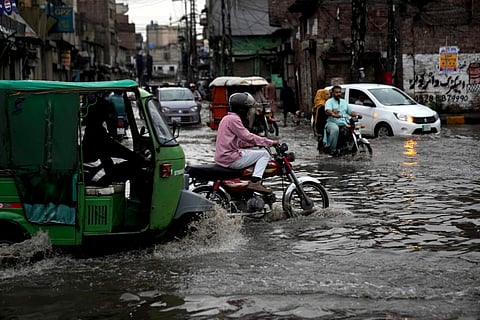Turning the tide: Building a flood-resilient Pakistan
From disaster response to planning, Pakistan must act decisively to protect lives

Relentless monsoon rains and flash floods have battered Pakistan over the past month, leaving many dead and injured. From the mountainous north to the flood-prone plains of Sindh and Punjab, the country is once again grappling with devastation. Roads have vanished, homes have crumbled, and lives have been upended. The Pakistan Meteorological Department has already issued warnings of above-normal rainfall for the remainder of the monsoon season, with forecasts unable to rule out a repeat of the catastrophic 2022 floods. As usual, the country scrambles for a reactive response, barely managing to cope with another round of human and economic suffering.
This is not an isolated event. Pakistan has endured catastrophic floods repeatedly — in 2010, 2014, and most notoriously in 2022. That year, record-breaking rainfall, glacial melt, and poor infrastructure planning combined to unleash a disaster that submerged nearly one-third of the country. Over 1,700 people were killed, more than two million homes destroyed or damaged, and a staggering 33 million people were affected. In economic terms, the country suffered more than $30 billion in damages.
Extreme weather
While the primary culprit was extreme weather, the recurring nature of these catastrophes bares the structural vulnerabilities that continue to fester unchecked: inadequate drainage systems, unchecked urban sprawl, fragile embankments, and a near-total absence of climate-resilient development. These flaws are not new. They persist due to state apathy, administrative lethargy, and a political culture that prizes short-term optics over long-term sustainability.
Floods in Pakistan don’t just wash away homes — they drown lives, livelihoods, and futures, particularly those of the underprivileged who typically reside in the most vulnerable geographies.
When disasters strike, it’s these communities that suffer the most. Children fall sick from waterborne diseases; women walk miles in search of clean water; farmers lose entire seasons of crops. A calamity that is manageable with proper planning becomes existential because of systemic neglect. And once the rains stop and the news cycle moves on, the poor are left to rebuild their lives on their own — brick by brick, year after year.
Emergency response
In response to such disasters, governments actions are reactive and short-term. Emergency food parcels and tents are not substitutes for climate-resilient housing, drainage infrastructure, or community preparedness programs.
Despite decentralisation policies that theoretically empower provincial and municipal governments, the reality on the ground is bleak. Local governments lack the capacity, resources, and authority to design and execute sustainable urban planning or flood mitigation projects. At the federal level, political instability and institutional inefficiency prevent any meaningful coordination.
The National Disaster Management Authority (NDMA) is chronically underfunded and overstretched, and its coordination with provincial disaster agencies remains subpar. Year after year, the script doesn’t change: forecast, flood, emergency relief, donor appeal, media attention, and then silence — until the next deluge.
Climate-affected
According to the Climate Risk Index 2025 by Germanwatch, Pakistan was the most climate-affected country in 2022. Its vulnerability is structural and multifaceted. Though it contributes less than 1 percent to global greenhouse gas emissions, Pakistan faces one of the world’s highest disaster risks due to its geography, economic structure, and social vulnerability.
The fundamental failure is one of foresight and planning. Pakistan knows its vulnerabilities: monsoonal patterns, glacial melt, rapid urbanization, and increasing climate volatility. Yet, year after year, little is done to mitigate the impending risks. Investments in flood-resilient infrastructure, early warning systems, or reforestation campaigns remain inadequate.
At the core of Pakistan’s climate crisis lies a deeply fractured political landscape. Governance is consumed by power struggles, judicial interference, and elite entrenchment. Rulers remain obsessed with clinging to office, instead of focusing on the needs of the people.
The climate crisis does not win votes, nor does investing in drainage or disaster preparedness make for good political optics. So, these are sidelined. The result is a state machinery paralysed by its own political insecurities and incapable of strategic, long-term thinking. Until the state shifts its priorities, millions will continue to pay the price with their lives and livelihoods.
Pakistan cannot afford to treat climate change as a seasonal inconvenience. It is a systemic crisis that threatens national security, food sovereignty, economic growth, and social stability. The state must invest in climate-resilient infrastructure, revamp its disaster management apparatus, enforce environmental laws, and integrate climate science into development planning.
Decentralised governments must be empowered with real financial and technical resources. Civil society, media, and academia must be involved in building public awareness. Urban planning must be reoriented around sustainability, and agriculture must be made drought- and flood-resilient.
More importantly, the ruling elite must understand that governing means more than surviving — it means protecting the people. The floods will return. But they need not become disasters. That depends on whether Pakistan decides to act before the waters rise again.
Sajjad Ashraf served as an adjunct professor at the Lee Kuan Yew School of Public Policy, National University of Singapore from 2009 to 2017. He was a member of Pakistan Foreign Service from 1973 to 2008 and served as an ambassador to several countries.
Sign up for the Daily Briefing
Get the latest news and updates straight to your inbox





